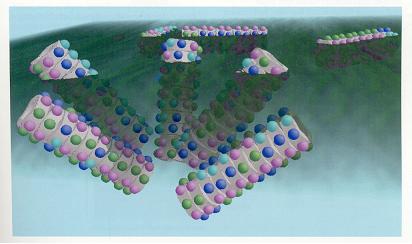Contribute
| Technology - Healthcare, Therapeutics, And Diagnostics: Using Nanotechnology For Better Disease Detection And Treatment |
National Nanotechnology Initiative
07/05/2004
(This article is sponsored by The Boston Group)
Challenge
Three critical areas within healthcare, therapeutics, and diagnostics lend themselves to nanoscale science and technology solutions. The first is improved implants developed by using biocompatible materials, tissue engineering, and regenerative medicine. The second is delivery of drugs, gene therapies, and other therapeutics. The third is earlier detection of disease, which could greatly enhance the success rate of existing treatment strategies and significantly advance our ability to employ prevention strategies.
Vision
Biological phenomena are largely governed by nanoscale structures. For example, the mechanisms of protein synthesis, replication, signal transduction, and infection occur at the nanoscale. Therefore, advances in a wide range of nanoscale science and technology will be relevant to biological research, and vice versa. Special opportunities exist for collaboration among life scientists and physical scientists. Collaborative programs leverage the knowledge base from each discipline, affording the best opportunities to shift life science paradigms from "hypothesis-driven" to mechanistic understanding.
As we achieve a better understanding of the design of biomolecular systems and learn how to build and control materials at this size scale, technologies for intervening in biological processes will emerge. These technologies offer promising routes to earlier detection of disease, more effective diagnostics and therapeutics, novel bioconipatible materials, targeted gene and drug delivery systems, novel vision and hearing aids, and "smart" medical devices for treatment modes that minimize collateral damage.
Research Example:
Peptide Nanotubes as Antibacterial Drugs
Bacterial resistance to antibiotics is a growing
problem worldwide that is compromising the medical community's ability to treat many infectious diseases. Most antibiotics used today target invading bacteria by latching onto specific molecules in the bacteria's outer membrane. If the bacteria can modify those molecules even slightly, they become resistant to the antibiotic and can go on to infect their host.
Researchers at the Scripps Research Institute in San Diego have developed peptide nanotubes, shown schematically in Fig. 1, that kill bacteria by punching holes in the bacteria's membrane. Each tube is formed from strings of amino acid subunits called peptides that, because of their structure, assemble into tiny rings. These rings stack on top of each other to form tubes on the order of barely one nanometer in diameter. By controlling the type of peptides used to build the rings, scientists are able to design nanotubes that selectively perforate bacterial membranes without harming the cells of the host.
In theory, these nano-bio agents should be far less prone than existing antibiotics to the development of bacterial resistance. The invading bacterium would have to substantially alter its membrane, not just alter a particular molecule, to become resistant to the nanotubes. Even if bacteria succeeded in altering their membranes, scientists could counter by modifying the structure of the nanotubes. Moreover, peptide nanotubes are resistant to proteases (protein-digesting enzymes found in the body) and therefore bypass a common problem in designing antibiotic agents.
You may also access this article through our web-site http://www.lokvani.com/

Fig. 1 - Schematic of designed peptide nanotubes that have penetrated a bacteri~1 cell wall, effectively killing the bacterium. The nanotubes are formed from stacks of rings, which in turn are made up of various peptides (indicated by colored dots) (courtesy A Olson andM.R Ghadiri, Scripps Research Institute).
